what cam cant i put into a stock 351w to give it more power?
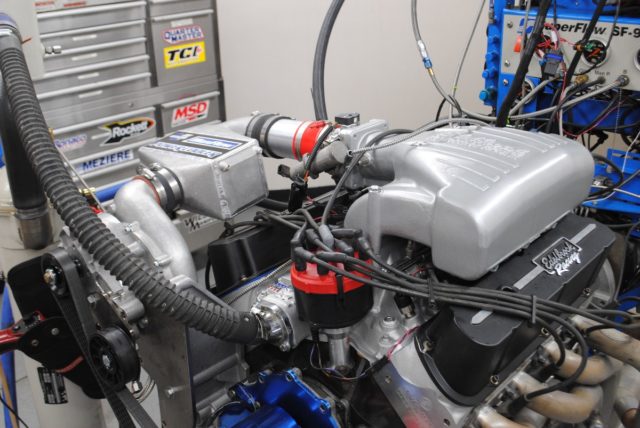
Modern Ford performance is alive and well, but ask whatsoever late-model Mustang owner. While the electric current crop of Coyote 5.0-liters are impressive performers, you are non as likely to find one at your local wrecking yard. Even if you were to come across a Coyote for sale, it would exist considerably more expensive than the many 351 Windsors we plant on our latest trip to the junkyard.
There were no Coyotes to be had, and but a few modernistic motors (all of which were the Two-Valve 4.vi- and 5.iv-liter multifariousness), but the k was full of the fuel-injected five.0- and 5.viii-liter Windsor motors. Sure, the early small-blocks can't compete with a Coyote (or mod motor) in stock trim, merely the one thing they take going for them is tremendous aftermarket support.
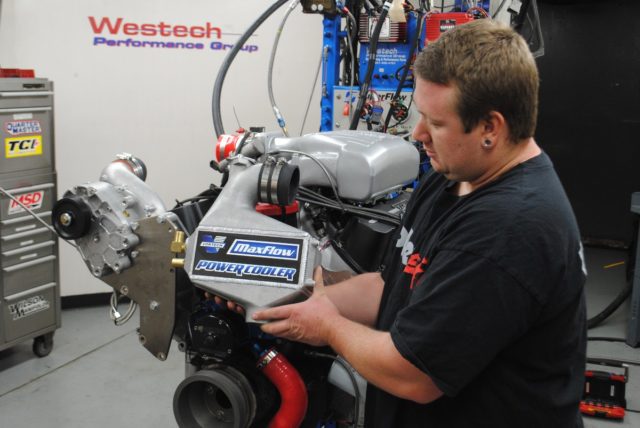
Taking the 351 Windsor to the max meant combining the right bolts-ons with intercooled boost!
…The respond to whatsoever performance question is almost always "heave."

Couple the availability of upgrades with endless years of research and development performed past enthusiasts, and you accept the makings of a mild motor just begging to become wild. To illustrate the hidden potential of an injected 351 Windsor, nosotros upgraded a 5.eight-liter V8 with better hardware and then added boost. The result was ane impressive street motor, with enough left on the table should you lot determine to go serious.
For those that might be new to the operation world, the answer to whatever performance question is well-nigh e'er "boost." Whether information technology's street or strip, stock or modified, everything is meliorate with boost. The simply thing libation than boost is (of course) intercooled boost. To bulldoze this betoken home, we applied intercooled boost to a 351 Windsor.
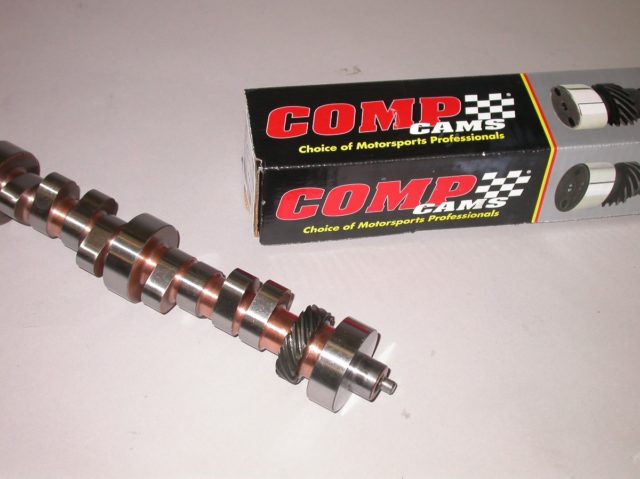
Before running on the dyno, we augmented the 351W truck motor with a COMP Cams upgrade. The XE282HR cam featured a .565/.574 lift split, a 232/240-caste duration split and 112-caste lobe separation.
Boosting Performance
In this example, a Vortech V3 Si supercharger supplied that heave. On paper, the V3 certainly looked impressive, capable of flowing one,150 cfm, delivering upwardly to 22 psi and producing upward of 750 horsepower (a rating we know to exist on the bourgeois side). None of those upper limits would ever come into play on our Windsor, but it was overnice to know the V3 Si offered such high adiabatic efficiency (meaning lower charge temps nether heave). Naturally, we besides liked the self-contained oiling that eliminated the need to supply a loftier-pressure feed or provide a drain-back in the oil pan.
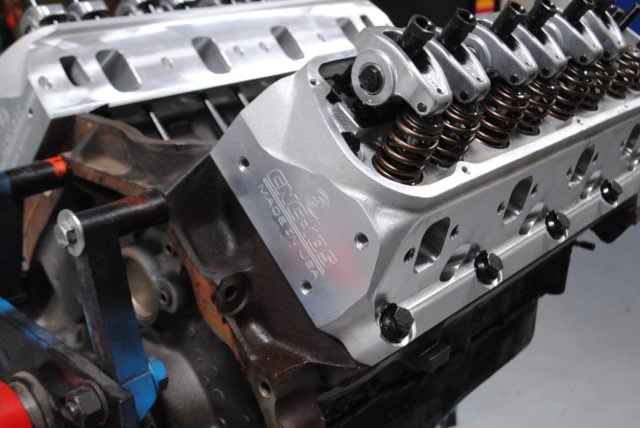
The Edelbrock aluminum E-CNC heads feature high-flow, 185cc intake ports; 75cc exhaust ports; and 59cc combustion chambers. Note the use of beehive springs and COMP Cams cast-aluminum roller rockers.
Heave from any source can best be described every bit a multiplier of the usually aspirated power. The more powerful the normally aspirated combination, the more power it will make under heave. Knowing this, we made sure the 351 Windsor was plenty powerful before adding the Vortech. Starting with a loftier-mileage, junkyard 5.8-liter, nosotros retained the stock short-block, but augmented the consecration with components from Edelbrock and COMP Cams.

Vortech V-3 Si Performance Specs
Internal Step-Upwardly Ratio: 3.61:1
Max Speed: 52,000 rpm
Max Heave: 26 psi
Max Flow: 1,150 cfm
Max Power: 775 horsepower
Peak Efficiency: 78 percentage
We swapped out the stock truck cam in favor of COMP'southward Xtreme Energy 282. The XE282HR features a .565/.574 elevator split, a 232/240-caste duration separate and 112-caste lobe separation. The cam was teamed with a set of Edelbrock's East-CNC 185 heads retained by ARP fasteners. As their name implies, these heads featured 185cc intake ports that flow a whopping 292 cfm, enough to support 600 horsepower on the correct application. Feeding the heads is an Edelbrock Performer RPM II upper and lower intake fitted with a gear up of FAST 36-lb/hr injectors, an Accufab 75mm throttle torso and a Holley HP fuel-injection organization.
A two-piece Performer RPM Two upper and lower intake topped the E-CNC heads. This long-runner intake offered a squeamish residual of torque and top-finish horsepower. Feeding the Edelbrock intake was a 75mm Accufab throttle body. Nosotros bolted up the IAC but didn't utilise it with the Holley HP management system.
Natural Progression
Before installation of the supercharger, we ran the modified 351W on the dyno using a set of i ¾-inch Hooker headers, an MSD distributor and a Meziere electric water pump. With this configuration, the naturally aspirated 351W delivered peak outputs of 418 horsepower at 5,800 rpm and 423 lb-ft of torque at iv,700 rpm.
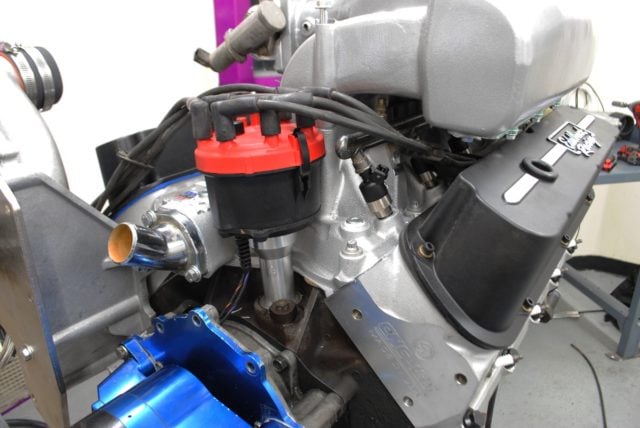
This MSD billet distributor and matching plug wires handled the ignition chores. Spark energy is doubly important on a supercharged application.
At this boost level, the supercharged and intercooled 351W produced peak numbers of 626 horsepower and 577 lb-ft of torque.

With a proper baseline recorded, it was time for some heave. We fabricated brusque work of installing the Vortech V3 onto the awaiting Windsor, including the air-to-water Maxflow Powercooler. Though we ran other pulley combinations, the all-time results came from a 3.0-inch blower pulley run in conjunction with the supplied 6.0-inch crank pulley. This produced a 2:1 drive ratio for the blower. When we combined this with the internal step-up ratio of 3.6:1 and vi,000 rpm engine speed, the caster philharmonic produced a maximum impeller speed of 43,200 rpm. This was well below the 52,000 rpm limit recommend by Vortech, and resulted in a maximum heave pressure of 8.5 psi.
At this boost level, the supercharged and intercooled 351W produced top numbers of 626 horsepower and 577 lb-ft of torque. Datalogging during the run indicated that the intercooler was knocking over lxx degrees of charge temperature out of the charge air (from 88 to 159 degrees). We did find a slight drop in boost beyond the cadre as well, an indication that it might exist fourth dimension to look for a larger core if you lot program to max-out your Windsor, but for now, this supercharged 351 was one cool customer.
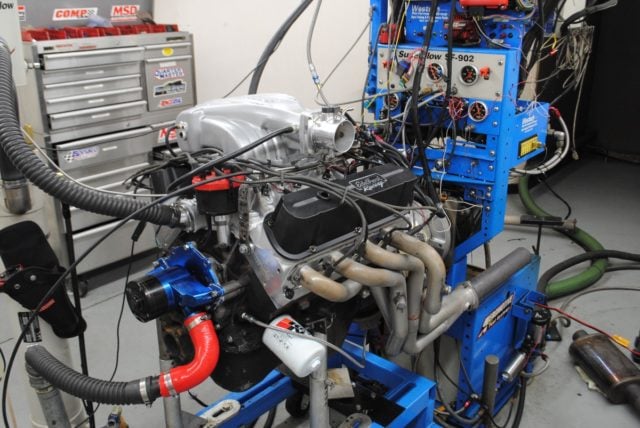
Run on the engine dyno at Westech Performance, the naturally aspirated 351 Windsor produced summit numbers of 418 horsepower at 5,800 rpm and 423 lb-ft of torque at iv,700 rpm. The upper intake was reversed for testing to clear the fuel pressure regulator.
In anticipation of boost, we replaced the 36-lb/hour FAST injectors run on the naturally aspirated combo with 50 pounders from Holley. To monitor inlet air temps, we positioned an air-temp sensor merely behind the throttle body on our supercharged 351.
We so installed the blower bracket and mounting plate. The mounting bracket was secured to the Edelbrock cylinder caput using the supplied hardware. No other accessories were employed on the test engine. The supplied 6-inch blower caster was secured to the factory damper. This resulted in a blower drive ratio of 2:1 when combined with the 3.0-inch blower pulley. A mounting plate with 5 3/viii-inch mounting bolts and washers retained the Vortech V3 centrifugal supercharger. Though we also tested a Ti-trim supercharger, the self-contained V3 was more than adequate but at this power level.
The highlight of the intercooled kit was, of course, the Maxflow Ability Cooler. Positioned betwixt the supercharger and throttle body, the charge air cooler helped drop inlet air temps by over 70 degrees. The Powercooler was given a steady supply of ambient dyno h2o for our testing. At that place was plenty of power left in the combination, but you might call back most upgrading the intercooler if you plan on elevated power levels.
It is evident from the ability numbers that the Vortech supercharger improved the power output of an already healthy 351W. Starting out life as a junkyard domestic dog, the Windsor was upgraded with Edelbrock E-CNC heads, a COMP Cam and RPM II upper and lower intake. In normally aspirated trim, the 351W produced 418 horsepower and 423 lb-ft of torque. After installation of the intercooled Vortech V3, the power output jumped to 626 hp and 577 lb-ft of torque. The Powercooled Vortech added a cool 208 horsepower and 154 lb-ft of torque to the bottom line. To illustrate the drib in inlet air temps, nosotros positioned thermal probes earlier and after the MaxFlow PowerCooler. Running a peak heave of less than 9 psi, the inlet air temps coming out of the blower registered well-nigh 160 degrees, just the charge cooler dropped these below 90 degrees. Libation air non only helps amend power production, but it allows for increased boost and timing.
{ad:BLOCK
beaurepairewasludy.blogspot.com
Source: https://www.fordmuscle.com/tech-stories/power-adders/boosting-the-power-of-a-351-cube-junkyard-small-block/
0 Response to "what cam cant i put into a stock 351w to give it more power?"
Post a Comment